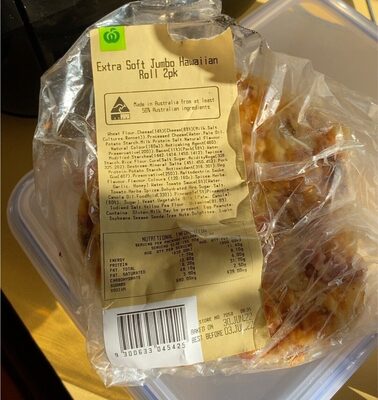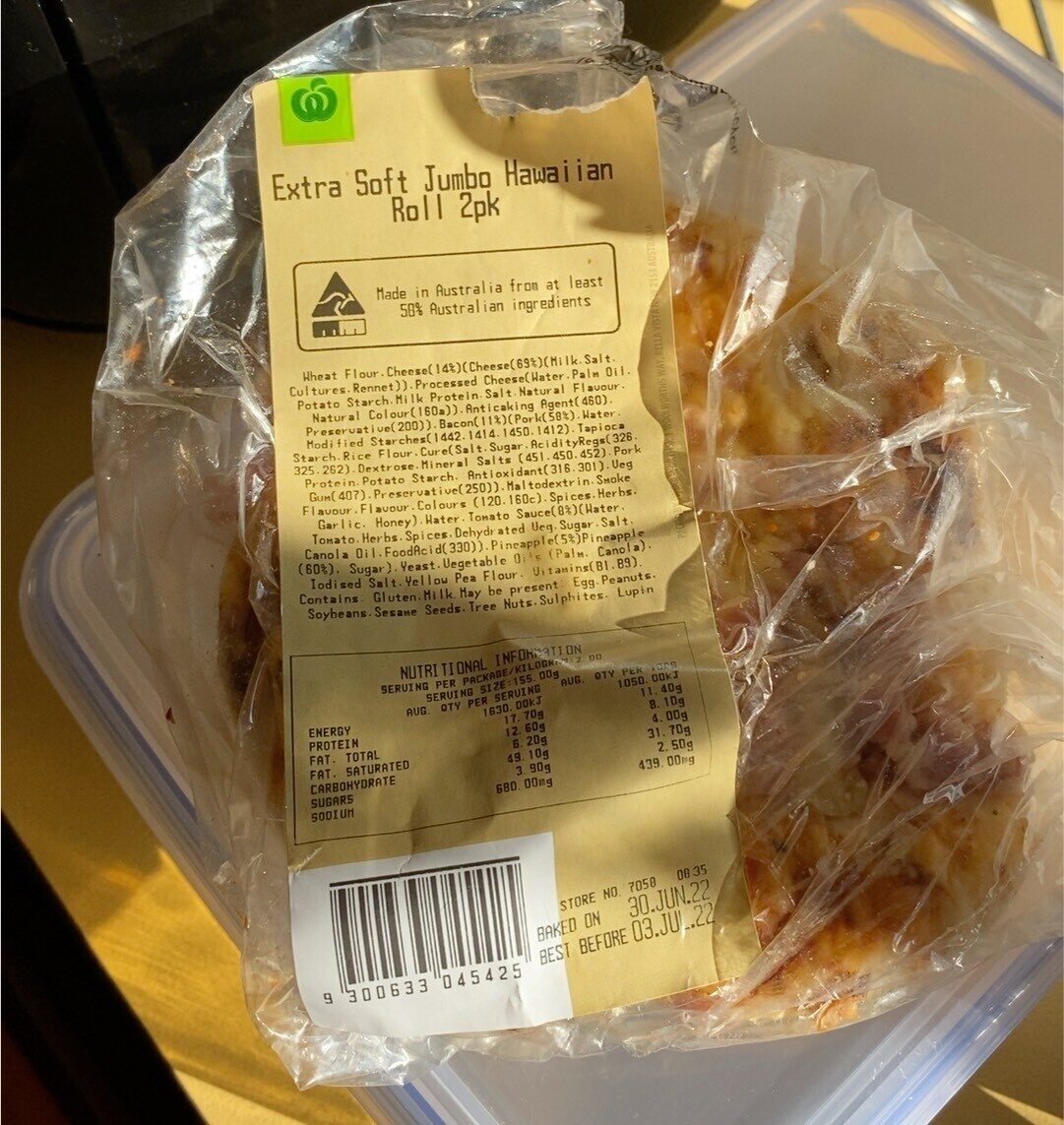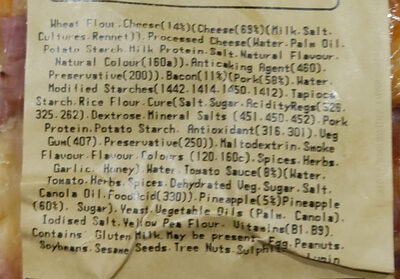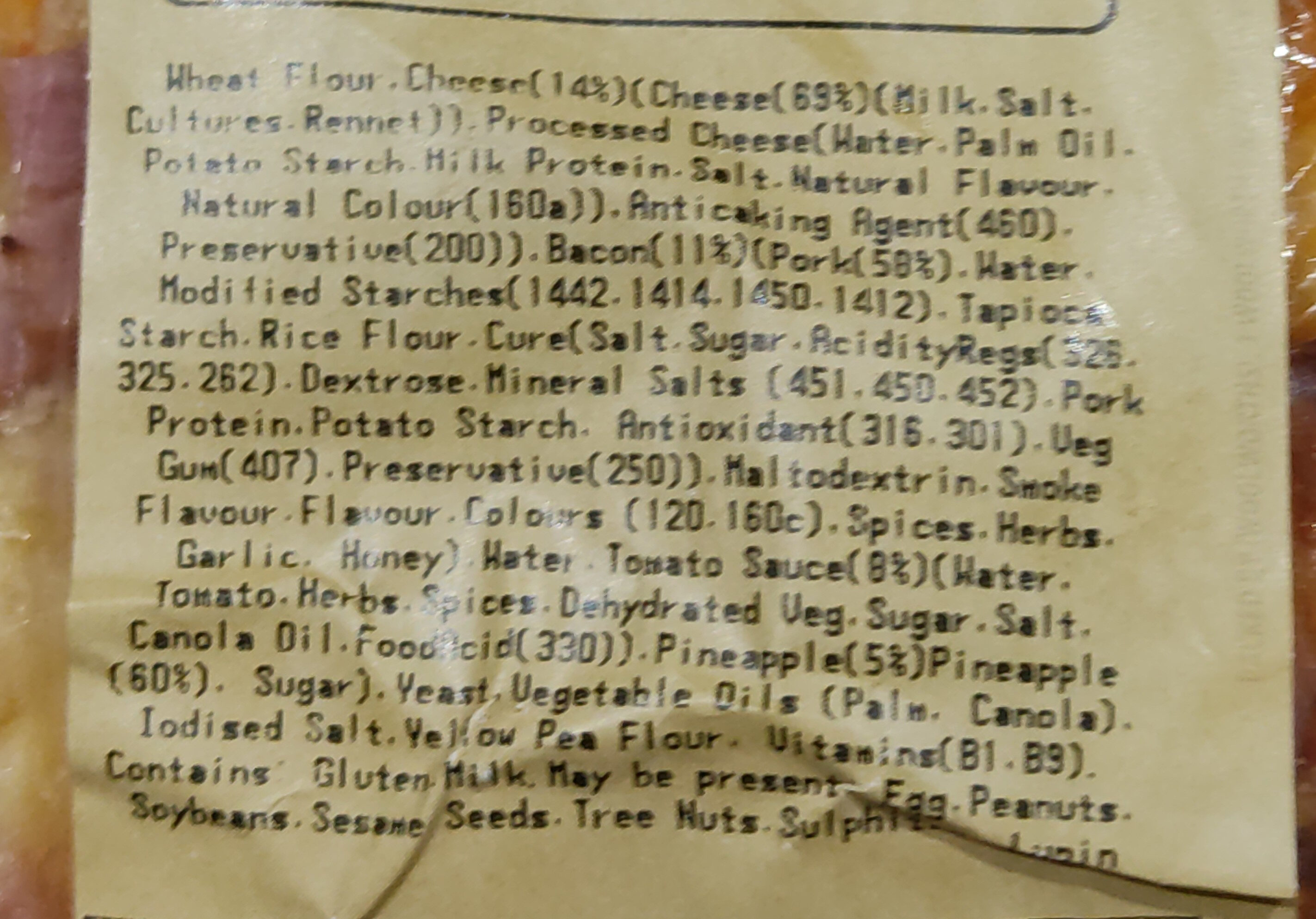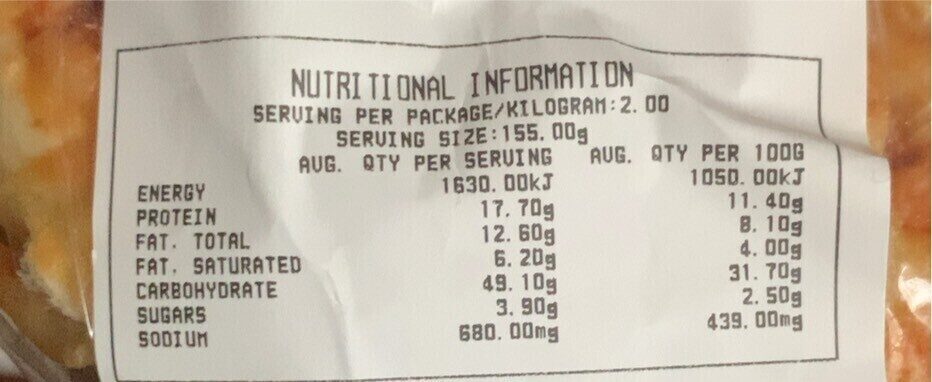Help us make food transparency the norm!
As a non-profit organization, we depend on your donations to continue informing consumers around the world about what they eat.
The food revolution starts with you!
Extra soft jombi Hawaiian roll - Woolworths - 2
Extra soft jombi Hawaiian roll - Woolworths - 2
This product page is not complete. You can help to complete it by editing it and adding more data from the photos we have, or by taking more photos using the app for Android or iPhone/iPad. Thank you!
×
Barcode: 9300633045425 (EAN / EAN-13)
Quantity: 2
Packaging: Plastic
Brands: Woolworths
Categories: Bread roll
Labels, certifications, awards: Australian made
Stores: Woolworth's, Woolworths
Countries where sold: Australia
Matching with your preferences
Health
Ingredients
-
85 ingredients
Wheat Flour, Cheese(14%)(Cheese(69%)(Milk, Salt, Cultures, Rennet)), Processed Cheese(Water, Palm Oil, Potato Starch, Mikk Protein, Salt, Natural Flavour, Natural Colour(160a)). Anticaking Agent(460), Preservative(200)), Bacon(11%)(Pork(58%), Water, Modified Starches(1442, 1414, 1450, 1412), Tapioca Starch, Rice Flour, Cure(Salt, Sugar, AcidityRegs(326, 325, 262), Dextrose, Mineral Salts (451, 450, 452), Pork Protein, Potato Starch, Antioxidant(316, 301), Veg Gum(407), Preservative(250)), Maltodextrin, Smoke Flavour, Flavour, Colours (120, 160c), Spices, Herbs. Garlic, Honey), Water, Tomato Sauce( 8%)(Water, Tomato, Herbs, Spices, Dehydrated Veg, Sugar, Salt, Canola Oil, Foodacid(330)), Pineapple(5%)Pineapple (60%), Sugar), Yeast, Vegetable Oils (Palm, Canola), Iodised Salt, Yellow Pea Flour, Vitamins(B1, B9). Contains Gluten, Milk May be present Eggs, Peanuts, Soybeans, Sesame Seeds, Tree Nuts, Sulphites, Lupin.Allergens: Gluten, Milk, PorkTraces: Eggs, Lupin, Nuts, Peanuts, Sesame seeds, Soybeans, Sulphur dioxide and sulphites, Contains-gluten, Milk-may-be-present-eggs
Food processing
-
Ultra processed foods
Elements that indicate the product is in the 4 - Ultra processed food and drink products group:
- Additive: E120 - Cochineal
- Additive: E1412 - Distarch phosphate
- Additive: E1414 - Acetylated distarch phosphate
- Additive: E1442 - Hydroxypropyl distarch phosphate
- Additive: E1450 - Starch sodium octenyl succinate
- Additive: E160a - Carotene
- Additive: E160c - Paprika extract
- Additive: E325 - Sodium lactate
- Additive: E326 - Potassium lactate
- Additive: E407 - Carrageenan
- Additive: E450 - Diphosphates
- Additive: E451 - Triphosphates
- Additive: E452 - Polyphosphates
- Additive: E460 - Cellulose
- Ingredient: Colour
- Ingredient: Dextrose
- Ingredient: Flavouring
- Ingredient: Glucose
- Ingredient: Maltodextrin
Food products are classified into 4 groups according to their degree of processing:
- Unprocessed or minimally processed foods
- Processed culinary ingredients
- Processed foods
- Ultra processed foods
The determination of the group is based on the category of the product and on the ingredients it contains.
Additives
-
E120 - Cochineal
Carminic acid: Carminic acid -C22H20O13- is a red glucosidal hydroxyanthrapurin that occurs naturally in some scale insects, such as the cochineal, Armenian cochineal, and Polish cochineal. The insects produce the acid as a deterrent to predators. An aluminum salt of carminic acid is the coloring agent in carmine. Synonyms are C.I. 75470 and C.I. Natural Red 4. The chemical structure of carminic acid consists of a core anthraquinone structure linked to a glucose sugar unit. Carminic acid was first synthesized in the laboratory by organic chemists in 1991.Source: Wikipedia
-
E1442 - Hydroxypropyl distarch phosphate
Hydroxypropyl distarch phosphate: Hydroxypropyl distarch phosphate -HDP- is a modified resistant starch. It is currently used as a food additive -INS number 1442-. It is approved for use in the European Union -listed as E1442-, the United States, Australia, Taiwan, and New Zealand.Source: Wikipedia
-
E160a - Carotene
Carotene: The term carotene -also carotin, from the Latin carota, "carrot"- is used for many related unsaturated hydrocarbon substances having the formula C40Hx, which are synthesized by plants but in general cannot be made by animals -with the exception of some aphids and spider mites which acquired the synthesizing genes from fungi-. Carotenes are photosynthetic pigments important for photosynthesis. Carotenes contain no oxygen atoms. They absorb ultraviolet, violet, and blue light and scatter orange or red light, and -in low concentrations- yellow light. Carotenes are responsible for the orange colour of the carrot, for which this class of chemicals is named, and for the colours of many other fruits, vegetables and fungi -for example, sweet potatoes, chanterelle and orange cantaloupe melon-. Carotenes are also responsible for the orange -but not all of the yellow- colours in dry foliage. They also -in lower concentrations- impart the yellow coloration to milk-fat and butter. Omnivorous animal species which are relatively poor converters of coloured dietary carotenoids to colourless retinoids have yellowed-coloured body fat, as a result of the carotenoid retention from the vegetable portion of their diet. The typical yellow-coloured fat of humans and chickens is a result of fat storage of carotenes from their diets. Carotenes contribute to photosynthesis by transmitting the light energy they absorb to chlorophyll. They also protect plant tissues by helping to absorb the energy from singlet oxygen, an excited form of the oxygen molecule O2 which is formed during photosynthesis. β-Carotene is composed of two retinyl groups, and is broken down in the mucosa of the human small intestine by β-carotene 15‚15'-monooxygenase to retinal, a form of vitamin A. β-Carotene can be stored in the liver and body fat and converted to retinal as needed, thus making it a form of vitamin A for humans and some other mammals. The carotenes α-carotene and γ-carotene, due to their single retinyl group -β-ionone ring-, also have some vitamin A activity -though less than β-carotene-, as does the xanthophyll carotenoid β-cryptoxanthin. All other carotenoids, including lycopene, have no beta-ring and thus no vitamin A activity -although they may have antioxidant activity and thus biological activity in other ways-. Animal species differ greatly in their ability to convert retinyl -beta-ionone- containing carotenoids to retinals. Carnivores in general are poor converters of dietary ionone-containing carotenoids. Pure carnivores such as ferrets lack β-carotene 15‚15'-monooxygenase and cannot convert any carotenoids to retinals at all -resulting in carotenes not being a form of vitamin A for this species-; while cats can convert a trace of β-carotene to retinol, although the amount is totally insufficient for meeting their daily retinol needs.Source: Wikipedia
-
E200 - Sorbic acid
Sorbic acid: Sorbic acid, or 2‚4-hexadienoic acid, is a natural organic compound used as a food preservative. It has the chemical formula CH3-CH-4CO2H. It is a colourless solid that is slightly soluble in water and sublimes readily. It was first isolated from the unripe berries of the Sorbus aucuparia -rowan tree-, hence its name.Source: Wikipedia
-
E250 - Sodium nitrite
Sodium nitrite: Sodium nitrite is the inorganic compound with the chemical formula NaNO2. It is a white to slightly yellowish crystalline powder that is very soluble in water and is hygroscopic. It is a useful precursor to a variety of organic compounds, such as pharmaceuticals, dyes, and pesticides, but it is probably best known as a food additive to prevent botulism. It is on the World Health Organization's List of Essential Medicines, the most important medications needed in a basic health system.Nitrate or nitrite -ingested- under conditions that result in endogenous nitrosation has been classified as "probably carcinogenic to humans" by International Agency for Research on Cancer -IARC-.Source: Wikipedia
-
E262 - Sodium acetates
Sodium acetate: Sodium acetate, CH3COONa, also abbreviated NaOAc, is the sodium salt of acetic acid. This colorless deliquescent salt has a wide range of uses.Source: Wikipedia
-
E301 - Sodium ascorbate
Sodium ascorbate: Sodium ascorbate is one of a number of mineral salts of ascorbic acid -vitamin C-. The molecular formula of this chemical compound is C6H7NaO6. As the sodium salt of ascorbic acid, it is known as a mineral ascorbate. It has not been demonstrated to be more bioavailable than any other form of vitamin C supplement.Sodium ascorbate normally provides 131 mg of sodium per 1‚000 mg of ascorbic acid -1‚000 mg of sodium ascorbate contains 889 mg of ascorbic acid and 111 mg of sodium-. As a food additive, it has the E number E301 and is used as an antioxidant and an acidity regulator. It is approved for use as a food additive in the EU, USA, and Australia and New Zealand.In in vitro studies, sodium ascorbate has been found to produce cytotoxic effects in various malignant cell lines, which include melanoma cells that are particularly susceptible.Source: Wikipedia
-
E316 - Sodium erythorbate
Sodium erythorbate: Sodium erythorbate -C6H7NaO6- is a food additive used predominantly in meats, poultry, and soft drinks. Chemically, it is the sodium salt of erythorbic acid. When used in processed meat such as hot dogs and beef sticks, it increases the rate at which nitrite reduces to nitric oxide, thus facilitating a faster cure and retaining the pink coloring. As an antioxidant structurally related to vitamin C, it helps improve flavor stability and prevents the formation of carcinogenic nitrosamines. When used as a food additive, its E number is E316. The use of erythorbic acid and sodium erythorbate as a food preservative has increased greatly since the U.S. Food and Drug Administration banned the use of sulfites as preservatives in foods intended to be eaten fresh -such as ingredients for fresh salads- and as food processors have responded to the fact that some people are allergic to sulfites. It can also be found in bologna, and is occasionally used in beverages, baked goods, and potato salad.Sodium erythorbate is produced from sugars derived from different sources, such as beets, sugar cane, and corn. An urban myth claims that sodium erythorbate is made from ground earthworms; however, there is no truth to the myth. It is thought that the genesis of the legend comes from the similarity of the chemical name to the words earthworm and bait.Alternative applications include the development of additives that could be utilized as anti-oxidants in general. For instance, this substance has been implemented in the development of corrosion inhibitors for metals and it has been implemented in active packaging.Sodium erythorbate is soluble in water. The pH of the aqueous solution of the sodium salt is between 5 and 6. A 10% solution, made from commercial grade sodium erythorbate, may have a pH of 7.2 to 7.9. In its dry, crystalline state it is nonreactive. But, when in solution with water it readily reacts with atmospheric oxygen and other oxidizing agents, which makes it a valuable antioxidant.Source: Wikipedia
-
E325 - Sodium lactate
Sodium lactate: Sodium lactate is the sodium salt of lactic acid, and has a mild saline taste. It is produced by fermentation of a sugar source, such as corn or beets, and then, by neutralizing the resulting lactic acid to create a compound having the formula NaC3H5O3.Source: Wikipedia
-
E326 - Potassium lactate
Potassium lactate: Potassium lactate is a compound with formula KC3H5O3, or H3C-CHOH-COOK. It is the potassium salt of lactic acid. It is produced by neutralizing lactic acid which is fermented from a sugar source. It has E number "E326". Potassium lactate is a liquid product that is usually 60% solids but is available at up to 78% solids.Potassium lactate is commonly used in meat and poultry products to extend shelf life and increase food safety as it has a broad antimicrobial action and is effective at inhibiting most spoilage and pathogenic bacteria. Potassium lactate is also used as an extinguishing medium in the First Alert Tundra fire extinguishers.Source: Wikipedia
-
E330 - Citric acid
Citric acid is a natural organic acid found in citrus fruits such as lemons, oranges, and limes.
It is widely used in the food industry as a flavor enhancer, acidulant, and preservative due to its tart and refreshing taste.
Citric acid is safe for consumption when used in moderation and is considered a generally recognized as safe (GRAS) food additive by regulatory agencies worldwide.
-
E407 - Carrageenan
Carrageenan (E407), derived from red seaweed, is widely employed in the food industry as a gelling, thickening, and stabilizing agent, notably in dairy and meat products.
It can exist in various forms, each imparting distinct textural properties to food.
However, its degraded form, often referred to as poligeenan, has raised health concerns due to its potential inflammatory effects and its classification as a possible human carcinogen (Group 2B) by the International Agency for Research on Cancer (IARC).
Nevertheless, food-grade carrageenan has been deemed safe by various regulatory bodies when consumed in amounts typically found in food.
-
E450 - Diphosphates
Diphosphates (E450) are food additives often utilized to modify the texture of products, acting as leavening agents in baking and preventing the coagulation of canned food.
These salts can stabilize whipped cream and are also found in powdered products to maintain their flow properties. They are commonly present in baked goods, processed meats, and soft drinks.
Derived from phosphoric acid, they're part of our daily phosphate intake, which often surpasses recommended levels due to the prevalence of phosphates in processed foods and drinks.
Excessive phosphate consumption is linked to health issues, such as impaired kidney function and weakened bone health. Though diphosphates are generally regarded as safe when consumed within established acceptable daily intakes, it's imperative to monitor overall phosphate consumption to maintain optimal health.
-
E451 - Triphosphates
Sodium triphosphate: Sodium triphosphate -STP-, also sodium tripolyphosphate -STPP-, or tripolyphosphate -TPP-,- is an inorganic compound with formula Na5P3O10. It is the sodium salt of the polyphosphate penta-anion, which is the conjugate base of triphosphoric acid. It is produced on a large scale as a component of many domestic and industrial products, especially detergents. Environmental problems associated with eutrophication are attributed to its widespread use.Source: Wikipedia
-
E460 - Cellulose
Cellulose: Cellulose is an organic compound with the formula -C6H10O5-n, a polysaccharide consisting of a linear chain of several hundred to many thousands of β-1→4- linked D-glucose units. Cellulose is an important structural component of the primary cell wall of green plants, many forms of algae and the oomycetes. Some species of bacteria secrete it to form biofilms. Cellulose is the most abundant organic polymer on Earth. The cellulose content of cotton fiber is 90%, that of wood is 40–50%, and that of dried hemp is approximately 57%.Cellulose is mainly used to produce paperboard and paper. Smaller quantities are converted into a wide variety of derivative products such as cellophane and rayon. Conversion of cellulose from energy crops into biofuels such as cellulosic ethanol is under development as a renewable fuel source. Cellulose for industrial use is mainly obtained from wood pulp and cotton.Some animals, particularly ruminants and termites, can digest cellulose with the help of symbiotic micro-organisms that live in their guts, such as Trichonympha. In human nutrition, cellulose is a non-digestible constituent of insoluble dietary fiber, acting as a hydrophilic bulking agent for feces and potentially aiding in defecation.Source: Wikipedia
Ingredients analysis
-
Palm oil
Ingredients that contain palm oil: Palm oil, Palm
-
Non-vegan
Non-vegan ingredients: Cheese, Cheese, Milk, Bacon, Pork, Pork protein, HoneySome ingredients could not be recognized.
We need your help!
You can help us recognize more ingredients and better analyze the list of ingredients for this product and others:
- Edit this product page to correct spelling mistakes in the ingredients list, and/or to remove ingredients in other languages and sentences that are not related to the ingredients.
- Add new entries, synonyms or translations to our multilingual lists of ingredients, ingredient processing methods, and labels.
If you would like to help, join the #ingredients channel on our Slack discussion space and/or learn about ingredients analysis on our wiki. Thank you!
-
Non-vegetarian
Non-vegetarian ingredients: Bacon, Pork, Pork proteinSome ingredients could not be recognized.
We need your help!
You can help us recognize more ingredients and better analyze the list of ingredients for this product and others:
- Edit this product page to correct spelling mistakes in the ingredients list, and/or to remove ingredients in other languages and sentences that are not related to the ingredients.
- Add new entries, synonyms or translations to our multilingual lists of ingredients, ingredient processing methods, and labels.
If you would like to help, join the #ingredients channel on our Slack discussion space and/or learn about ingredients analysis on our wiki. Thank you!
-
Details of the analysis of the ingredients
We need your help!
Some ingredients could not be recognized.
We need your help!
You can help us recognize more ingredients and better analyze the list of ingredients for this product and others:
- Edit this product page to correct spelling mistakes in the ingredients list, and/or to remove ingredients in other languages and sentences that are not related to the ingredients.
- Add new entries, synonyms or translations to our multilingual lists of ingredients, ingredient processing methods, and labels.
If you would like to help, join the #ingredients channel on our Slack discussion space and/or learn about ingredients analysis on our wiki. Thank you!
en: Wheat Flour, Cheese 14% (Cheese 69% (Milk, Salt, Cultures, Rennet)), Processed Cheese (Water, Palm Oil, Potato Starch, Mikk Protein, Salt, Natural Flavour, Natural Colour (160a)), Anticaking Agent (460), Preservative (200), Bacon 11%, Pork 58%, Water, Modified Starches (1442, 1414, 1450, 1412), Tapioca Starch, Rice Flour, Cure (Salt, Sugar, AcidityRegs (326, 325, 262), Dextrose, Mineral Salts (451, 450, 452), Pork Protein, Potato Starch, Antioxidant (316, 301), Veg Gum (407), Preservative (250)), Maltodextrin, Smoke Flavour, Flavour, Colours (120, 160c), Spices, Herbs, Garlic, Honey, Water, Tomato Sauce 8% (Water, Tomato, Herbs, Spices, Dehydrated Veg, Sugar, Salt, Canola Oil, Foodacid (330)), Pineapple 5%, Pineapple 60%, Sugar, Yeast, Vegetable Oils (Palm, Canola), Iodised Salt, Yellow Pea, vitamins, vitamin B1, vitamin B9- Wheat Flour -> en:wheat-flour - vegan: yes - vegetarian: yes - ciqual_proxy_food_code: 9410
- Cheese -> en:cheese - vegan: no - vegetarian: maybe - ciqual_proxy_food_code: 12999 - percent: 14
- Cheese -> en:cheese - vegan: no - vegetarian: maybe - ciqual_proxy_food_code: 12999 - percent: 69
- Milk -> en:milk - vegan: no - vegetarian: yes - ciqual_proxy_food_code: 19051
- Salt -> en:salt - vegan: yes - vegetarian: yes - ciqual_food_code: 11058
- Cultures -> en:microbial-culture - vegan: maybe - vegetarian: maybe
- Rennet -> en:rennet - vegan: maybe - vegetarian: maybe
- Cheese -> en:cheese - vegan: no - vegetarian: maybe - ciqual_proxy_food_code: 12999 - percent: 69
- Processed Cheese -> en:processed-cheese
- Water -> en:water - vegan: yes - vegetarian: yes - ciqual_food_code: 18066
- Palm Oil -> en:palm-oil - vegan: yes - vegetarian: yes - from_palm_oil: yes - ciqual_food_code: 16129
- Potato Starch -> en:potato-starch - vegan: yes - vegetarian: yes - ciqual_proxy_food_code: 9510
- Mikk Protein -> en:mikk-protein
- Salt -> en:salt - vegan: yes - vegetarian: yes - ciqual_food_code: 11058
- Natural Flavour -> en:natural-flavouring - vegan: maybe - vegetarian: maybe
- Natural Colour -> en:natural-colours
- 160a -> en:160a
- Anticaking Agent -> en:anti-caking-agent
- 460 -> en:460
- Preservative -> en:preservative
- 200 -> en:200
- Bacon -> en:bacon - vegan: no - vegetarian: no - ciqual_food_code: 28858 - percent: 11
- Pork -> en:pork - vegan: no - vegetarian: no - percent: 58
- Water -> en:water - vegan: yes - vegetarian: yes - ciqual_food_code: 18066
- Modified Starches -> en:modified-starch - vegan: yes - vegetarian: yes - ciqual_proxy_food_code: 9510
- 1442 -> en:1442
- 1414 -> en:1414
- 1450 -> en:1450
- 1412 -> en:1412
- Tapioca Starch -> en:tapioca - vegan: yes - vegetarian: yes - ciqual_proxy_food_code: 9510
- Rice Flour -> en:rice-flour - vegan: yes - vegetarian: yes - ciqual_food_code: 9520
- Cure -> en:cure
- Salt -> en:salt - vegan: yes - vegetarian: yes - ciqual_food_code: 11058
- Sugar -> en:sugar - vegan: yes - vegetarian: yes - ciqual_proxy_food_code: 31016
- AcidityRegs -> en:acidityregs
- 326 -> en:326
- 325 -> en:325
- 262 -> en:262
- Dextrose -> en:dextrose - vegan: yes - vegetarian: yes - ciqual_proxy_food_code: 31016
- Mineral Salts -> en:mineral-salts
- 451 -> en:451
- 450 -> en:450
- 452 -> en:452
- Pork Protein -> en:pork-protein - vegan: no - vegetarian: no
- Potato Starch -> en:potato-starch - vegan: yes - vegetarian: yes - ciqual_proxy_food_code: 9510
- Antioxidant -> en:antioxidant
- 316 -> en:316
- 301 -> en:301
- Veg Gum -> en:veg-gum
- 407 -> en:407
- Preservative -> en:preservative
- 250 -> en:250
- Maltodextrin -> en:maltodextrin - vegan: yes - vegetarian: yes
- Smoke Flavour -> en:smoke-flavouring - vegan: maybe - vegetarian: maybe
- Flavour -> en:flavouring - vegan: maybe - vegetarian: maybe
- Colours -> en:colour
- 120 -> en:120
- 160c -> en:160c
- Spices -> en:spice - vegan: yes - vegetarian: yes
- Herbs -> en:herb - vegan: yes - vegetarian: yes
- Garlic -> en:garlic - vegan: yes - vegetarian: yes - ciqual_food_code: 11000
- Honey -> en:honey - vegan: no - vegetarian: yes - ciqual_food_code: 31008
- Water -> en:water - vegan: yes - vegetarian: yes - ciqual_food_code: 18066
- Tomato Sauce -> en:tomato-sauce - vegan: maybe - vegetarian: maybe - ciqual_proxy_food_code: 11107 - percent: 8
- Water -> en:water - vegan: yes - vegetarian: yes - ciqual_food_code: 18066
- Tomato -> en:tomato - vegan: yes - vegetarian: yes - ciqual_food_code: 20047
- Herbs -> en:herb - vegan: yes - vegetarian: yes
- Spices -> en:spice - vegan: yes - vegetarian: yes
- Dehydrated Veg -> en:dehydrated-veg
- Sugar -> en:sugar - vegan: yes - vegetarian: yes - ciqual_proxy_food_code: 31016
- Salt -> en:salt - vegan: yes - vegetarian: yes - ciqual_food_code: 11058
- Canola Oil -> en:canola-oil - vegan: yes - vegetarian: yes - from_palm_oil: no
- Foodacid -> en:foodacid
- 330 -> en:330
- Pineapple -> en:pineapple - vegan: yes - vegetarian: yes - percent: 5
- Pineapple -> en:pineapple - vegan: yes - vegetarian: yes - percent: 60
- Sugar -> en:sugar - vegan: yes - vegetarian: yes - ciqual_proxy_food_code: 31016
- Yeast -> en:yeast - vegan: yes - vegetarian: yes
- Vegetable Oils -> en:vegetable-oil - vegan: yes - vegetarian: yes - from_palm_oil: maybe
- Palm -> en:palm - vegan: yes - vegetarian: yes - from_palm_oil: yes - ciqual_food_code: 16129
- Canola -> en:canola - vegan: yes - vegetarian: yes
- Iodised Salt -> en:iodised-salt - vegan: yes - vegetarian: yes - ciqual_food_code: 11058
- Yellow Pea -> en:yellow-pea - vegan: yes - vegetarian: yes
- vitamins -> en:vitamins - vegan: yes - vegetarian: yes
- vitamin B1 -> en:thiamin
- vitamin B9 -> en:folic-acid
Nutrition
-
Average nutritional quality
⚠ ️Warning: the amount of fiber is not specified, their possible positive contribution to the grade could not be taken into account.⚠ ️Warning: the amount of fruits, vegetables and nuts is not specified on the label, it was estimated from the list of ingredients: 65This product is not considered a beverage for the calculation of the Nutri-Score.
Positive points: 7
- Proteins: 5 / 5 (value: 11.41935483871, rounded value: 11.42)
- Fiber: 0 / 5 (value: 0, rounded value: 0)
- Fruits, vegetables, nuts, and colza/walnut/olive oils: 2 / 5 (value: 65, rounded value: 65)
Negative points: 10
- Energy: 3 / 10 (value: 1050, rounded value: 1050)
- Sugars: 0 / 10 (value: 2.5161290322581, rounded value: 2.52)
- Saturated fat: 3 / 10 (value: 4, rounded value: 4)
- Sodium: 4 / 10 (value: 438.70967741936, rounded value: 438.7)
The points for proteins are counted because the negative points are less than 11.
Nutritional score: (10 - 7)
Nutri-Score:
-
Nutrient levels
-
Fat in moderate quantity (8.13%)
What you need to know- A high consumption of fat, especially saturated fats, can raise cholesterol, which increases the risk of heart diseases.
Recommendation: Limit the consumption of fat and saturated fat- Choose products with lower fat and saturated fat content.
-
Saturated fat in moderate quantity (4%)
What you need to know- A high consumption of fat, especially saturated fats, can raise cholesterol, which increases the risk of heart diseases.
Recommendation: Limit the consumption of fat and saturated fat- Choose products with lower fat and saturated fat content.
-
Sugars in low quantity (2.52%)
What you need to know- A high consumption of sugar can cause weight gain and tooth decay. It also augments the risk of type 2 diabetes and cardio-vascular diseases.
Recommendation: Limit the consumption of sugar and sugary drinks- Sugary drinks (such as sodas, fruit beverages, and fruit juices and nectars) should be limited as much as possible (no more than 1 glass a day).
- Choose products with lower sugar content and reduce the consumption of products with added sugars.
-
Salt in moderate quantity (1.1%)
What you need to know- A high consumption of salt (or sodium) can cause raised blood pressure, which can increase the risk of heart disease and stroke.
- Many people who have high blood pressure do not know it, as there are often no symptoms.
- Most people consume too much salt (on average 9 to 12 grams per day), around twice the recommended maximum level of intake.
Recommendation: Limit the consumption of salt and salted food- Reduce the quantity of salt used when cooking, and don't salt again at the table.
- Limit the consumption of salty snacks and choose products with lower salt content.
-
-
Nutrition facts
Nutrition facts As sold
for 100 g / 100 mlAs sold
per serving (155g)Energy 1,050 kj
(251 kcal)1,630 kj
(390 kcal)Fat 8.129 g 12.6 g Saturated fat 4 g 6.2 g Carbohydrates 31.677 g 49.1 g Sugars 2.516 g 3.9 g Fiber ? ? Proteins 11.419 g 17.7 g Salt 1.097 g 1.7 g Fruits‚ vegetables‚ nuts and rapeseed‚ walnut and olive oils (estimate from ingredients list analysis) 65 % 65 %
Environment
-
Eco-Score not computed - Unknown environmental impact
We could not compute the Eco-Score of this product as it is missing some data, could you help complete it?Could you add a precise product category so that we can compute the Eco-Score? Add a category
Packaging
-
Packaging with a medium impact
-
Packaging parts
(Plastic)
-
Packaging materials
Material % Packaging weight Plastic
-
Transportation
-
Origins of ingredients
Missing origins of ingredients information
⚠ ️ The origins of the ingredients of this product are not indicated.
If they are indicated on the packaging, you can modify the product sheet and add them.
If you are the manufacturer of this product, you can send us the information with our free platform for producers.Add the origins of ingredients for this product Add the origins of ingredients for this product
Threatened species
-
Contains palm oil
Drives deforestation and threatens species such as the orangutan
Tropical forests in Asia, Africa and Latin America are destroyed to create and expand oil palm tree plantations. The deforestation contributes to climate change, and it endangers species such as the orangutan, the pigmy elephant and the Sumatran rhino.
Report a problem
-
Incomplete or incorrect information?
Category, labels, ingredients, allergens, nutritional information, photos etc.
If the information does not match the information on the packaging, please complete or correct it. Open Food Facts is a collaborative database, and every contribution is useful for all.
Data sources
Product added on by andrew-c12
Last edit of product page on by teolemon.
Product page also edited by ecoscore-impact-estimator, kiliweb, openfoodfacts-contributors, packbot, roboto-app, yuka.sY2b0xO6T85zoF3NwEKvlkEbC8XnkhjoFTvTn020nN3TIqW4RNRx6K7CY6s, yuka.sY2b0xO6T85zoF3NwEKvlmZ6fd7QvjD9HQD5xhTS3sm1drHmfc9e_YTnHqo.
